Kushagra Tiwary
What if Eye...? Computationally Recreating Vision Evolution
Jan 25, 2025



Abstract:Vision systems in nature show remarkable diversity, from simple light-sensitive patches to complex camera eyes with lenses. While natural selection has produced these eyes through countless mutations over millions of years, they represent just one set of realized evolutionary paths. Testing hypotheses about how environmental pressures shaped eye evolution remains challenging since we cannot experimentally isolate individual factors. Computational evolution offers a way to systematically explore alternative trajectories. Here we show how environmental demands drive three fundamental aspects of visual evolution through an artificial evolution framework that co-evolves both physical eye structure and neural processing in embodied agents. First, we demonstrate computational evidence that task specific selection drives bifurcation in eye evolution - orientation tasks like navigation in a maze leads to distributed compound-type eyes while an object discrimination task leads to the emergence of high-acuity camera-type eyes. Second, we reveal how optical innovations like lenses naturally emerge to resolve fundamental tradeoffs between light collection and spatial precision. Third, we uncover systematic scaling laws between visual acuity and neural processing, showing how task complexity drives coordinated evolution of sensory and computational capabilities. Our work introduces a novel paradigm that illuminates evolutionary principles shaping vision by creating targeted single-player games where embodied agents must simultaneously evolve visual systems and learn complex behaviors. Through our unified genetic encoding framework, these embodied agents serve as next-generation hypothesis testing machines while providing a foundation for designing manufacturable bio-inspired vision systems.
Bridging the Data Provenance Gap Across Text, Speech and Video
Dec 19, 2024



Abstract:Progress in AI is driven largely by the scale and quality of training data. Despite this, there is a deficit of empirical analysis examining the attributes of well-established datasets beyond text. In this work we conduct the largest and first-of-its-kind longitudinal audit across modalities--popular text, speech, and video datasets--from their detailed sourcing trends and use restrictions to their geographical and linguistic representation. Our manual analysis covers nearly 4000 public datasets between 1990-2024, spanning 608 languages, 798 sources, 659 organizations, and 67 countries. We find that multimodal machine learning applications have overwhelmingly turned to web-crawled, synthetic, and social media platforms, such as YouTube, for their training sets, eclipsing all other sources since 2019. Secondly, tracing the chain of dataset derivations we find that while less than 33% of datasets are restrictively licensed, over 80% of the source content in widely-used text, speech, and video datasets, carry non-commercial restrictions. Finally, counter to the rising number of languages and geographies represented in public AI training datasets, our audit demonstrates measures of relative geographical and multilingual representation have failed to significantly improve their coverage since 2013. We believe the breadth of our audit enables us to empirically examine trends in data sourcing, restrictions, and Western-centricity at an ecosystem-level, and that visibility into these questions are essential to progress in responsible AI. As a contribution to ongoing improvements in dataset transparency and responsible use, we release our entire multimodal audit, allowing practitioners to trace data provenance across text, speech, and video.
DecentNeRFs: Decentralized Neural Radiance Fields from Crowdsourced Images
Mar 28, 2024Abstract:Neural radiance fields (NeRFs) show potential for transforming images captured worldwide into immersive 3D visual experiences. However, most of this captured visual data remains siloed in our camera rolls as these images contain personal details. Even if made public, the problem of learning 3D representations of billions of scenes captured daily in a centralized manner is computationally intractable. Our approach, DecentNeRF, is the first attempt at decentralized, crowd-sourced NeRFs that require $\sim 10^4\times$ less server computing for a scene than a centralized approach. Instead of sending the raw data, our approach requires users to send a 3D representation, distributing the high computation cost of training centralized NeRFs between the users. It learns photorealistic scene representations by decomposing users' 3D views into personal and global NeRFs and a novel optimally weighted aggregation of only the latter. We validate the advantage of our approach to learn NeRFs with photorealism and minimal server computation cost on structured synthetic and real-world photo tourism datasets. We further analyze how secure aggregation of global NeRFs in DecentNeRF minimizes the undesired reconstruction of personal content by the server.
SUNDIAL: 3D Satellite Understanding through Direct, Ambient, and Complex Lighting Decomposition
Dec 24, 2023



Abstract:3D modeling from satellite imagery is essential in areas of environmental science, urban planning, agriculture, and disaster response. However, traditional 3D modeling techniques face unique challenges in the remote sensing context, including limited multi-view baselines over extensive regions, varying direct, ambient, and complex illumination conditions, and time-varying scene changes across captures. In this work, we introduce SUNDIAL, a comprehensive approach to 3D reconstruction of satellite imagery using neural radiance fields. We jointly learn satellite scene geometry, illumination components, and sun direction in this single-model approach, and propose a secondary shadow ray casting technique to 1) improve scene geometry using oblique sun angles to render shadows, 2) enable physically-based disentanglement of scene albedo and illumination, and 3) determine the components of illumination from direct, ambient (sky), and complex sources. To achieve this, we incorporate lighting cues and geometric priors from remote sensing literature in a neural rendering approach, modeling physical properties of satellite scenes such as shadows, scattered sky illumination, and complex illumination and shading of vegetation and water. We evaluate the performance of SUNDIAL against existing NeRF-based techniques for satellite scene modeling and demonstrate improved scene and lighting disentanglement, novel view and lighting rendering, and geometry and sun direction estimation on challenging scenes with small baselines, sparse inputs, and variable illumination.
DISeR: Designing Imaging Systems with Reinforcement Learning
Sep 25, 2023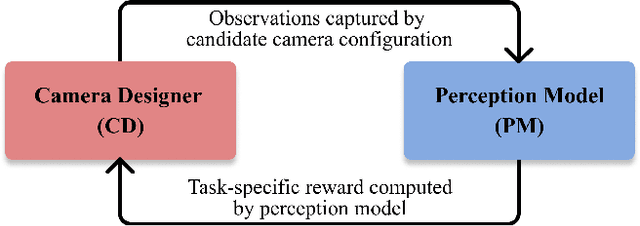

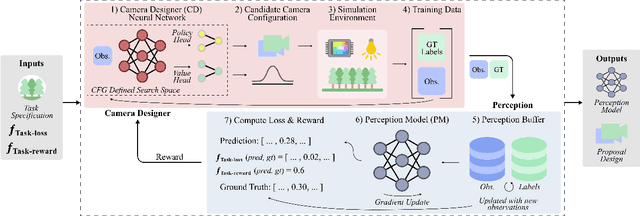
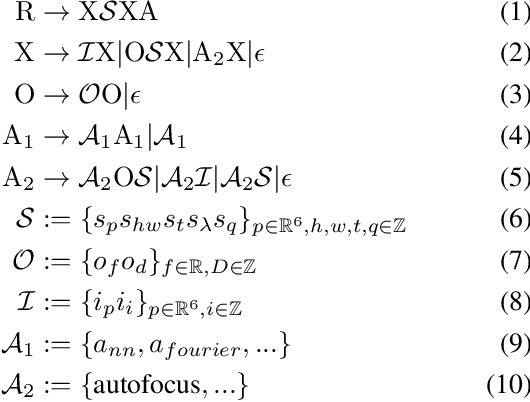
Abstract:Imaging systems consist of cameras to encode visual information about the world and perception models to interpret this encoding. Cameras contain (1) illumination sources, (2) optical elements, and (3) sensors, while perception models use (4) algorithms. Directly searching over all combinations of these four building blocks to design an imaging system is challenging due to the size of the search space. Moreover, cameras and perception models are often designed independently, leading to sub-optimal task performance. In this paper, we formulate these four building blocks of imaging systems as a context-free grammar (CFG), which can be automatically searched over with a learned camera designer to jointly optimize the imaging system with task-specific perception models. By transforming the CFG to a state-action space, we then show how the camera designer can be implemented with reinforcement learning to intelligently search over the combinatorial space of possible imaging system configurations. We demonstrate our approach on two tasks, depth estimation and camera rig design for autonomous vehicles, showing that our method yields rigs that outperform industry-wide standards. We believe that our proposed approach is an important step towards automating imaging system design.
ORCa: Glossy Objects as Radiance Field Cameras
Dec 12, 2022

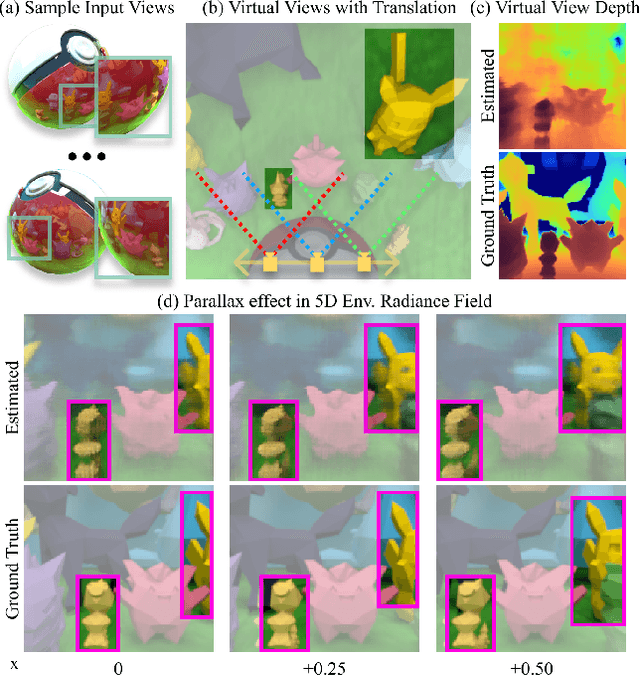
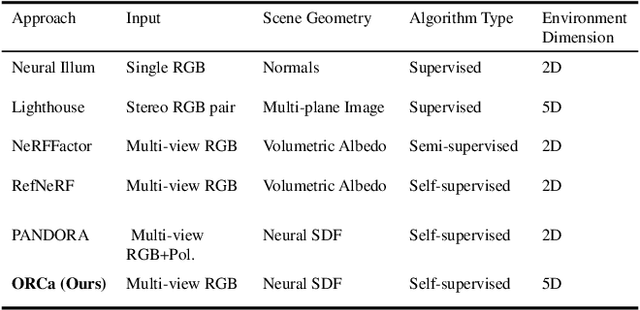
Abstract:Reflections on glossy objects contain valuable and hidden information about the surrounding environment. By converting these objects into cameras, we can unlock exciting applications, including imaging beyond the camera's field-of-view and from seemingly impossible vantage points, e.g. from reflections on the human eye. However, this task is challenging because reflections depend jointly on object geometry, material properties, the 3D environment, and the observer viewing direction. Our approach converts glossy objects with unknown geometry into radiance-field cameras to image the world from the object's perspective. Our key insight is to convert the object surface into a virtual sensor that captures cast reflections as a 2D projection of the 5D environment radiance field visible to the object. We show that recovering the environment radiance fields enables depth and radiance estimation from the object to its surroundings in addition to beyond field-of-view novel-view synthesis, i.e. rendering of novel views that are only directly-visible to the glossy object present in the scene, but not the observer. Moreover, using the radiance field we can image around occluders caused by close-by objects in the scene. Our method is trained end-to-end on multi-view images of the object and jointly estimates object geometry, diffuse radiance, and the 5D environment radiance field.
Physics vs. Learned Priors: Rethinking Camera and Algorithm Design for Task-Specific Imaging
Apr 21, 2022



Abstract:Cameras were originally designed using physics-based heuristics to capture aesthetic images. In recent years, there has been a transformation in camera design from being purely physics-driven to increasingly data-driven and task-specific. In this paper, we present a framework to understand the building blocks of this nascent field of end-to-end design of camera hardware and algorithms. As part of this framework, we show how methods that exploit both physics and data have become prevalent in imaging and computer vision, underscoring a key trend that will continue to dominate the future of task-specific camera design. Finally, we share current barriers to progress in end-to-end design, and hypothesize how these barriers can be overcome.
Physically Disentangled Representations
Apr 11, 2022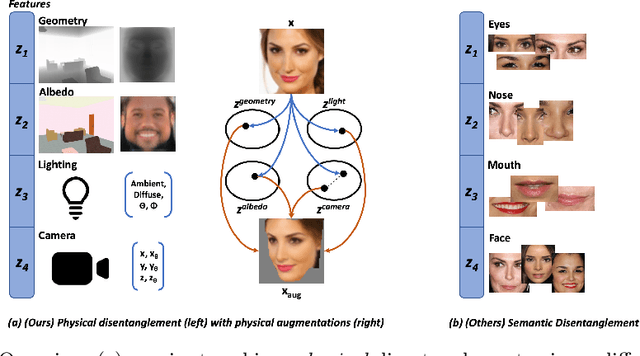

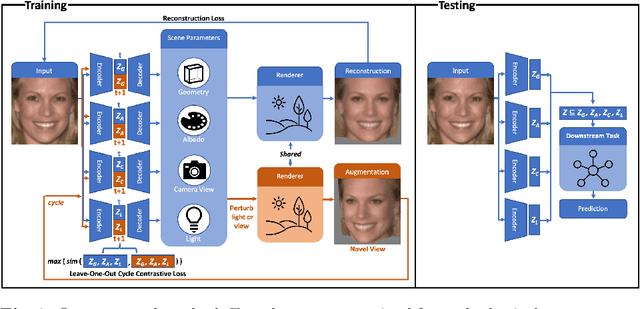

Abstract:State-of-the-art methods in generative representation learning yield semantic disentanglement, but typically do not consider physical scene parameters, such as geometry, albedo, lighting, or camera. We posit that inverse rendering, a way to reverse the rendering process to recover scene parameters from an image, can also be used to learn physically disentangled representations of scenes without supervision. In this paper, we show the utility of inverse rendering in learning representations that yield improved accuracy on downstream clustering, linear classification, and segmentation tasks with the help of our novel Leave-One-Out, Cycle Contrastive loss (LOOCC), which improves disentanglement of scene parameters and robustness to out-of-distribution lighting and viewpoints. We perform a comparison of our method with other generative representation learning methods across a variety of downstream tasks, including face attribute classification, emotion recognition, identification, face segmentation, and car classification. Our physically disentangled representations yield higher accuracy than semantically disentangled alternatives across all tasks and by as much as 18%. We hope that this work will motivate future research in applying advances in inverse rendering and 3D understanding to representation learning.
Towards Learning Neural Representations from Shadows
Mar 29, 2022

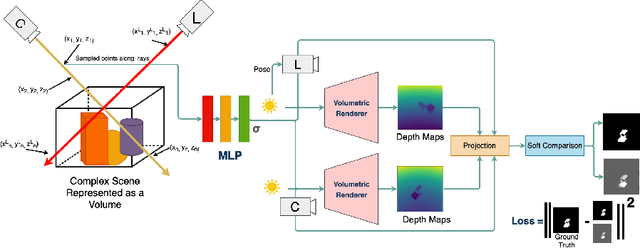

Abstract:We present a method that learns neural scene representations from only shadows present in the scene. While traditional shape-from-shadow (SfS) algorithms reconstruct geometry from shadows, they assume a fixed scanning setup and fail to generalize to complex scenes. Neural rendering algorithms, on the other hand, rely on photometric consistency between RGB images but largely ignore physical cues such as shadows, which have been shown to provide valuable information about the scene. We observe that shadows are a powerful cue that can constrain neural scene representations to learn SfS, and even outperform NeRF to reconstruct otherwise hidden geometry. We propose a graphics-inspired differentiable approach to render accurate shadows with volumetric rendering, predicting a shadow map that can be compared to the ground truth shadow. Even with just binary shadow maps, we show that neural rendering can localize the object and estimate coarse geometry. Our approach reveals that sparse cues in images can be used to estimate geometry using differentiable volumetric rendering. Moreover, our framework is highly generalizable and can work alongside existing 3D reconstruction techniques that otherwise only use photometric consistency. Our code is made available in our supplementary materials.
 Add to Chrome
Add to Chrome Add to Firefox
Add to Firefox Add to Edge
Add to Edge